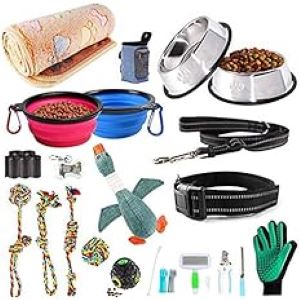When we shift from one house to another, there is a sense of anxiety. Some people feel good about such changes and others get anxious or worried. In fact, the smallest of changes in the normal routine can drive humans crazy. So, what about our canine friends?
Rehoming a dog is a big step and, has a severe impact on the dogs. Whether it’s rescuing, adopting or any dog owner giving away the dog, this is a sudden drastic shift in their lifestyle and changing dynamics can have different psychological effects on the canines. Hence, you need to think – How does a dog feel when rehomed? Let’s find out.
You Might Also Like:
How Does a Dog Feel When Rehomed?
Generally, you will see dogs feel anxious, scared, or stressed after they are rehomed. In addition, there are a variety of emotions they may feel, such as – confusion, sadness, depression, relief, happiness or excitement.
So, if you rehome your dog or bring a new one from a rescue shelter you will see a different range of emotions. Let’s elaborate on the anxiety, stress and sadness aspect and observe the variance in the dog’s behaviour after rehoming.

1. Anxiety
The dog showing anxious behaviour is their go-to response to new changes in their environment. Also, they are quite shy and nervous while interacting in a new environment. Following are some of the signs indicating that the dog is anxious:
- Excessive barking or whining
- Escape attempts
- Continuous panting and pacing
- Chewing stuff and destroying furniture
- Tail tucking, trembling and hiding
- Low appetite
- Self-harm
- Shaking (rapid heart rate)
It’s crucial for dog owners to remember that many dogs have faced abuse or had negative experiences in their previous households. So, their anxiety and nervousness can also trigger their aggression and they will exhibit destructive behaviour.
2. Stress
Now, when the dog is under stress, it will refuse to eat food, show no interest in playing or exercising, and growl or bark continuously for no reason. Sometimes they even end up biting their new owners when they try to get close to them. So, here are some of the behaviour you will observe in your stressed dog:
- Shedding of fur
- Licking, yawning and excessive drooling
- Try escaping the house
- Hiding in the house
- Rapid eye blinking, dilated pupils, or tacked ears
- Body posture changes – tucking the tail or going tough when the owner approaches
3. Sadness
Dogs may have short-term memories but, they don’t forget their old owners. They can associate the person with their experience and also remember places. The bond with the old owner makes it hard for them to adjust to the new environment and their absence makes them sad. They will feel they were taken away from their owner.
So, after rehoming, a stressed dog will show different behaviour:
- Be less attentive, not aware of the surrounding environment
- Sleep more
- Not obeying the new owner’s commands
- Bark or whine constantly
- Refuse to exercise or play at all
4. PTSD
Dogs after rehoming risk suffering from PTSD. The common behaviour symptoms in dogs while suffering from this condition include – anxiety, timidness and aggression. Their prior experiences make the dog dangerous because you cannot anticipate their behaviour.
So, it’s best you keep your family members away. A dog suffering from PTSD will show signs of hypervigilance, fearfulness, random aggression, hyperarousal, pooping or peeing in the house and so on.
The behaviour of dogs after rehoming
Anxiety, stress, sadness and PTSD often lead to different emotional behaviours after rehoming. Here are different behavioural traits of dogs which register their non-acceptance in the new environment.
- Shut down behaviour
The shutdown behaviours in rehomed dogs are quite normal. They will not follow any commands or are just scared of doing stuff because of the change in their house. In general, such shutdown behaviour is a result of their fear i.e. they think they will receive punishment if they make a mistake.
To overcome this situation, you can try consulting a behaviourist or vet. Meanwhile, you can try using some positive reinforcements, for instance, food treats to counter this behaviour. Remember, it’s not necessary they will eat what you serve, so, in the beginning, you may face this issue. But, if you allow them to move at their pace they will start accepting the food and their behaviour will also change.
- Aggressive behaviour
The aggression in dogs is random, it’s difficult to outline a specific reason. But, when they are exhibiting aggressive behaviour after being rehomed, chances are they have had a tough life back at the shelter or in the previous house.
For example, many dogs face constant abuse and harsh treatment from their owners or at the shelter. This makes them fearful and when they are in their new house they will panic after seeing the new owner. They will bark with aggression in an attempt to save themselves.
- Anxious behaviour
When a dog is rehomed, they are already suffering emotionally and possibly from separation anxiety. This anxiety reflects in their behaviour. You will see them follow you around because they just had a separation from their previous house and are worried that you might leave them as well.
- The hyperactive behaviour
Contrary to the shutdown behaviour, a hyperactive dog will roll over the place of the new owner. They are either extremely excited or on high alert while meeting their new owner. These dogs are energetic and you may see them jump on your sofas, furniture, bed, etc.
You can try relaxing the dog yourself using different techniques but, it won’t give proper results. You will need some assistance from the vet to calm down this hyperactive behaviour.
- Barking behaviour
Barking is normal behaviour but, if it is excessive, then you need to address the situation. Try figuring out whether this excessive barking behaviour is a result of anxiety, stress, or fear. Now, try controlling this behaviour, if there is no change, consult a vet.
Further, there is a rare prospect of dogs barking out of joy and excitement. Yes, it can happen! This can occur when they had a bad experience in a shelter home or the previous owner’s place was dull. Regardless, if your rehomed dog is excited and barking, it’s good.
- Peeing behaviour
If the dog is peeing in the house, then they are marking its new territory. The stress, anxiety, and feeling of insecurity of shifting to a new house take a heavy toll. By peeing they ensure their scent remains in different areas in the new house and make them feel secure.
In addition, a dog also goes through different physical changes during the time of such transition. The majority of the dogs will have digestive system issues, mainly constipation. Some may even suffer from weight loss, vomiting or diarrhoea after the rehoming is complete.
Further, some dogs will shiver and shake a lot as they are under stress and you will see them produce excessive saliva that will constantly drop out of their mouth. These physical changes will remain for a few days but, if your rehomed dog is getting proper care during the transition period you will see these symptoms fade soon.
Tips For Helping a Rehomed Dog Settle In Your House
It’s important you make the rehomed dog feel safe and secure in your house. Yes, it will take time, but, it’s crucial if you were to get along with your new furry friend. Here are some of the tips you can consider while you help the new dog settle in your house.

#1 Provide a safe space
Possibly the best way to make your new furry friend feel comfortable is to set up a dedicated space. You can also get insights from the previous owner or the shelter house regarding the arrangement. This is the place where they will go to sleep, relax and stuff their toys or some food items. Also, keep a comforting bed or mat around for them to sleep on.
While they settle in their new place, avoid physical contact, especially kissing or hugging. This can make them uncomfortable.
#2 Alone time
Once the dog gets accustomed to the space you provided, allow them to settle in at their own pace. Enforcing new activities or making them interact with family members can unsettle them and they may get anxious.
So, a walk in the park, physical training or exercise is completely out of the equation. If you try they will agitate because of the emotional turmoil they recently experienced and also they don’t trust you.
#3 Set up a routine
Now, when the dog is willingly coming out of their specific place, you can try bonding with them. Help them with their routine activities and build some trust. This is a significant and tough step to execute because they are either used to the shelter routine and food habits or of the previous owner.
Regardless, make sure that you don’t compel them into following their new routine. Here is what you can do:
- Start with their meals
- Take them for walks
- Play fetch
Setting up this basic routine can do wonders. These activities will help reduce the stress and anxiety that is in their minds and give them a much-needed refreshing feeling.
#4 Patience
Often dog owners lose their patience and give up on their new dog as well. This can traumatize the dog because they have already been rejected by its previous owner. You rejecting them can make their mental health even worse.
Patience is the key, make them feel you care and also realise that this place is safe for them to live in. Avoid scolding or punishing them for their mistakes while they are blending in the new atmosphere. For instance, if are continuously chewing on the sofa, furniture or other items, instead of shouting at them you can try holding them gently to calm them down.
#5 Interaction with the family
If the dog is obeying your command and feels safe around you, try introducing them to your family, friends and neighbours. Because at this stage they are aware of different smells, and noises around the house and the presence of a family member or close friend won’t bother or overwhelm them.
Now, to ensure that you get a proper dog in the house, here are some of the aspects you can consider while rehoming one:
- The dog must have good health even though you are rescuing it from the shelter.
- Know the details regarding dogs’ behaviour from the shelter and see if they are comfortable around children or other dogs. This can help you prepare yourself and the dog mentally.
- Taking in a random dog is something you should entirely avoid. You don’t know about their behaviour and this can hinder their transition and compromise rehoming.
FAQs
How do dogs cope with rehoming?
Dogs are considered man’s best friend, and the bond between a dog owner and their furry friend is very strong. In fact, Dr Deirdre Barrett, a clinical and evolutionary psychologist at Harvard Medical School, has even shown that dogs dream of their owner’s face. Hence, when they have to leave them or are abandoned, they get hugely traumatic. However, they also learn to love and trust again quickly.
What dog breed is most rehomed?
The most rehomed breed of dogs includes Pit bulls, German Shepherds, Labradors retrievers, Dachshunds, Boxers and chihuahuas. The reason behind this is their popularity amongst the community and the unfair breed stereotypes.
How much time will a dog take to adjust to their new owner after rehoming?
The time taken solely relies on the age of the dog. For instance, if you get a puppy, the transition is not so difficult because they bond instantly with their new owner. Adult dogs will take more time to settle in their new homes as they have to adjust to the new environment. Also, how swiftly the new owner manages to build the trust will have a significant impact on the time taken for adjustment. It could take weeks or months.
What is the rule of 3 for rehoming dogs?
The rule of 3 for rehoming dogs simply involves a guideline that specifies different phases. These phases will highlight the transition or the journey for the dog who will try and settle into a new environment. The rule goes like this- the first 3 days, 3 weeks, and 3 months of a dog from the day they were brought home from a rescue camp.
Are old dogs rehomed?
Yes, old dogs are rehomed and are wonderful companions as well. In fact, if you have some small pups around the house the presence of senior dogs can have a positive influence on them. They can easily grasp different habits and behaviour from the senior dogs.
How Does a Dog Feel When Rehomed – Final Take
If you are getting a dog from the shelter, you need complete preparation for welcoming the new dog into your life. The transition is tough and as a dog owner, it’s your responsibility to make the rehomed dog feel safe in your house. Feel free to consult a vet or a behaviourist after you get one home.
Further, if you are specifically looking to rescue a dog, take help from rescue centres to locate different dogs who need new owners and rehoming. This will help you get a dog who is genuinely in need of a new owner.






